The algorithm is the enemy of Surrealism
Or, how Surrealism can help with your pre-election anxiety!
To reduce the imagination to a state of slavery is to betray all sense of absolute justice within oneself. Imagination alone offers me some intimation of what can be.
André Breton, Manifesto of Surrealism (1924)
Remember those Tivoli radios that were really popular like 10 years ago? I recently moved mine to my kitchen counter and set the dial to my local NPR station. Now, instead of putting on whatever new podcast is in my feed, I flip on the radio.
Yes, okay, I know that Morning Edition will be on at 8 am. And I know that All Things Considered will be on at 4 pm. But otherwise? It feels a bit like rolling the dice. More often than not I end up hearing something kind of random, something unexpected, and — most importantly — something that I would not have turned on for myself.
I’m sure there’s a much better version of this game where I just spin the dial and see what it lands on. (And, listen: I’m not saying that NPR is some kind of Surrealist paradise lol.) But for now, even this small change — the radio instead of podcasts — feels like it’s significantly improving my life. But why?
If you know me, you might know that I hate the algorithm. It’s right up there with leaf blowers as a thing I love to rant about. There is nothing worse than the fucking Spotify algorithm, which will just play songs you already play or worse versions of things it thinks you like. But you know what I like? NEW THINGS. Things that surprise me. Things that change my mind. Things that challenge my worldview. You know where you’re not going to find things that surprise you? The Spotify algorithm. Or, honestly, probably a recommendation algorithm of any kind.
There’s been lots of discussion of the dulling effect of the algorithm in recent years. Kyle Chayka’s book Filterworld: How Algorithms Flattened Culture (2024) comes to mind. Or that Jia Tolentino essay on “Instagram Face” that I still think about constantly. But lately I’ve been thinking about the algorithm in the context of Surrealism. And I’m ready to declare the algorithm as the enemy of Surrealism.
Omg wtf is Surrealism
You know Surrealism. It’s this:
Briefly: Surrealism is an artistic/intellectual movement founded in Paris in the 1920s. In the Manifesto of Surrealism (1924), André Breton lays out the objectives of the movement: chiefly, getting beneath the conscious mind, the civilized mind, into the strange murkiness of the unconscious. He celebrates childhood, the dream world, and madness as states in which the mind is liberated from the constraints of society. Why? He thinks our “brains are dulled” by logic, objective reason, realism, and materialism. What does he want instead? He wants “the imagination which knows no bounds.” He wants the marvelous.
In their pursuit of the marvelous, the Surrealists depended heavily on chance. They played games, like the exquisite corpse, which use chance to bring things together in unexpected or unusual ways. They employed automatic writing, attempting to remove the conscious mind as mediator and funnel the subconscious onto the page. They would go on aimless walks called dérives, the goal of which was to stumble across the new, to notice or encounter things they hadn’t seen before, to discover the marvelous in their everyday surroundings. Fundamentally, all of these practices challenge you to see the familiar in a new way, shaking you out of your imagination-dulling routines and habits.1
But you know where chance and the new go to die? The algorithm.
Okay, sure. But why should I care?
Here are three reasons why you might consider making your life less algorithmically-driven and more Surrealist.
For your art
This one is obvious. Randomness, chance, seeing the world in a new way will all make your art better. Breaking habits of mind is essential for artists — you might even say it’s the artist’s job to step outside of habitual ways of thinking.
For your health
Apparently, paying attention to the new is good for us! (This makes intuitive sense, right?) On a recent episode of the 10% Happier podcast,2 Ellen Langer talks about how noticing new things improves our health:
As you’re actively noticing new things, the neurons are firing, and 45 years of research has shown me that that’s literally and figuratively enlivening. In very early studies, we took elderly people, we gave them instructions in this mindfulness act of noticing, and they did, they lived longer.
It’s not just longer life: Langer says that noticing new things will keep you in the present moment, help you make better choices, even make you more charismatic (because you seem more alive!). Is this just mindfulness? Sure, maybe. But it also kind of sounds like Ellen Langer wants you to go on a dérive.
For the world
It might sound like a platitude, but imagination is essential to building a better world. As bell hooks says, “how can you become what you cannot imagine?”:
To be truly visionary we have to root our imagination in our concrete reality while simultaneously imagining possibilities beyond that reality.3
Hmm. “Beyond reality,” you say. Could that be…Surreality?
A brief detour into Leonora’s world
One artist whose Surrealism allowed her to envision a better world is my beloved Leonora Carrington (1917–2011).
In her life, Leonora rejected convention in favor of imagination. She fled from her wealthy British parents, who wanted nothing more than for her to be a debutante and a wife; she rejected the Catholicism in which she was raised, finding herself drawn instead to magic and witchcraft; and she even distanced herself from the inner circle of the Surrealists themselves (and they loved her).
In her art, she created her own world in which traditional hierarchies are collapsed: the human is blended with the animal, the male with the female, the sacred with the mundane.
When I look at Carrington’s work, what I am most struck by is a sense of possibility. What new, strange, wondrous things might be possible if we could only imagine them?
I feel overwhelmed a lot of the time by the staggering problems the world is facing. I’m scared and anxious about what’s going to happen in the future, regardless of who wins this election. But when I look at Carrington’s radically re-imagined world, when I remember that we do not have to remain shackled to things as they are, I feel like maybe, just maybe, things are going to be okay.
So…wanna get a little Surrealist?
Whether you’re doing it for your art, for your health, or for our world, here are some recs that will help you access the marvelous.
Do a Surrealist activity!
Make an exquisite corpse with your friends. Go for a dérive. Pull some Tarot. I don’t know…take mushrooms? Anything to change up your perspective and see the world anew.
Read a Surrealist book!
You really can’t do better than The Hearing Trumpet (1974). Leonora Carrington is a goddam genius, what can I say?
Okay so technically Angela Carter’s Nights at the Circus (1984) might be classified as “magical realism.” But I’m calling it Surrealist. Sorry (not sorry).
Wow, Leonora Carrington, Angela Carter, and Helen Oyeyemi all in one post? Kill me now, I’m in heaven. I have read that Helen Oyeyemi does not like to label her work, but no one reminds me so much of Carrington or Carter as Oyeyemi. She’s one of my favorite living writers.
And finally, while you’re at it: read feminism is for everybody (2000) by bell hooks (cited above). That book changed my life. It may not be Surrealist, but it is visionary.
Look at some Surrealist art!
A handful of paintings by Leonora Carrington to get you started.4 Enjoy! And as we go into this anxiety-laden week, remember: “imagination alone offers some intimation of what can be.”
Thank you to my friend Elliot King for allowing me to sit in on his Surrealism class this fall and for teaching me these things.
Thank you to my friend Catherine Epstein for introducing me to 10% Happier! If you’re in Lexington, you should check out her mindfulness classes (and her mindfulness newsletter).
bell hooks, feminism is for everybody (2000), 110. If you want to see the quotation in context, I was looking at this version.
If you’re excited about Leonora Carrington and want to know more, check out Leonora Carrington: Surrealism, Alchemy and Art (2010) by Susan Aberth and The Tarot of Leonora Carrington (2021) by Susan Aberth and Tere Arcq. All of the Carrington images in this post are from those two books.

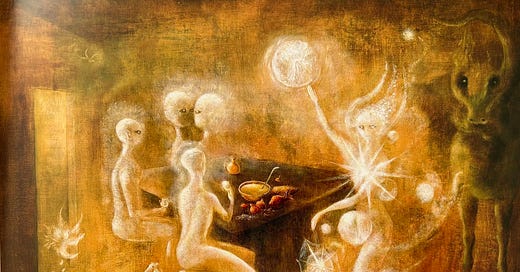



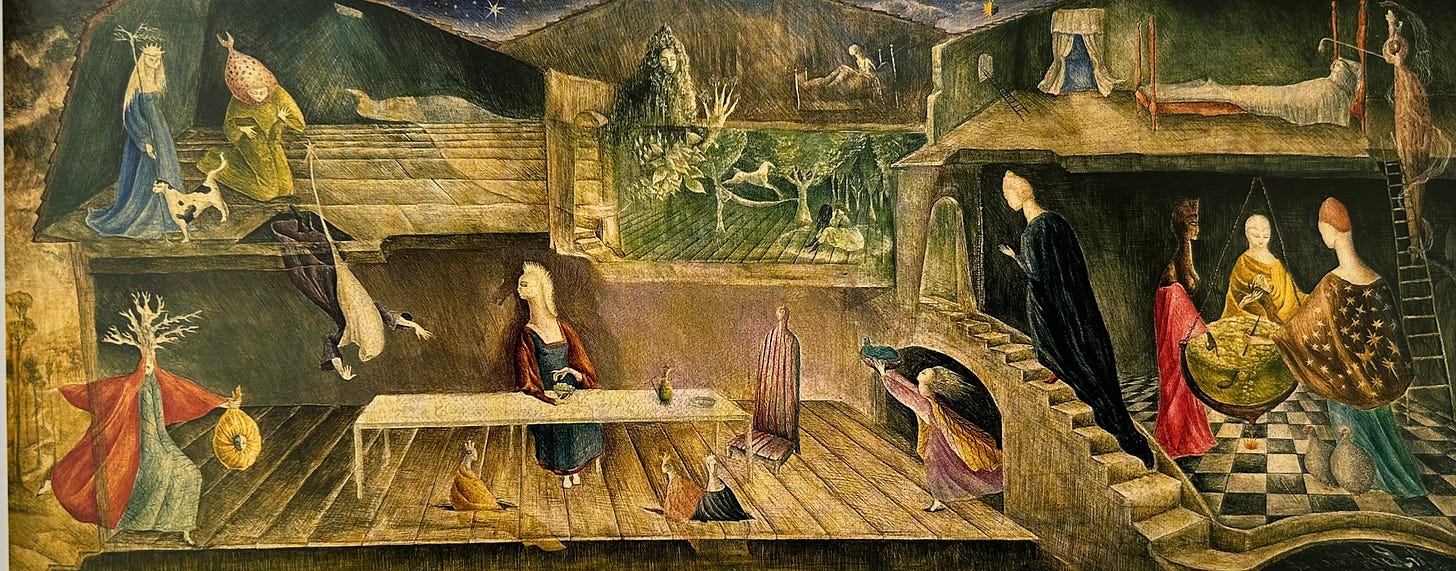
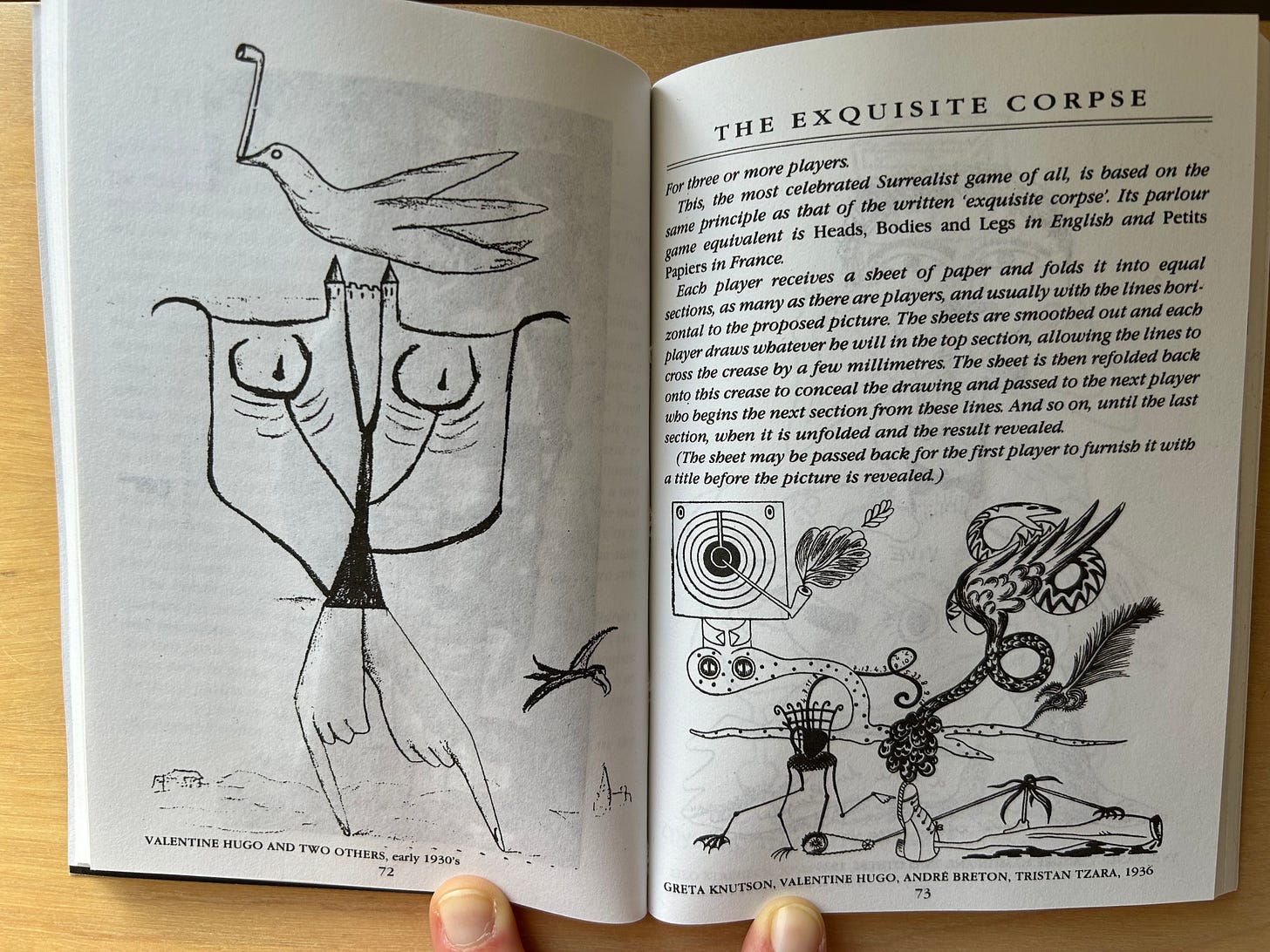

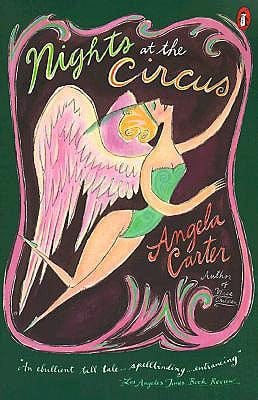
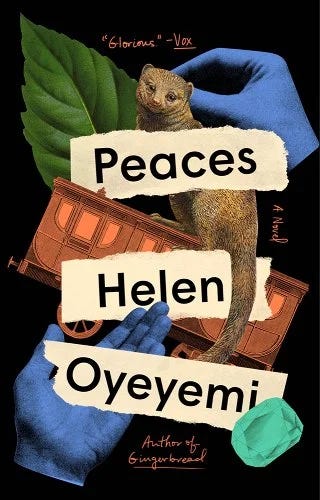
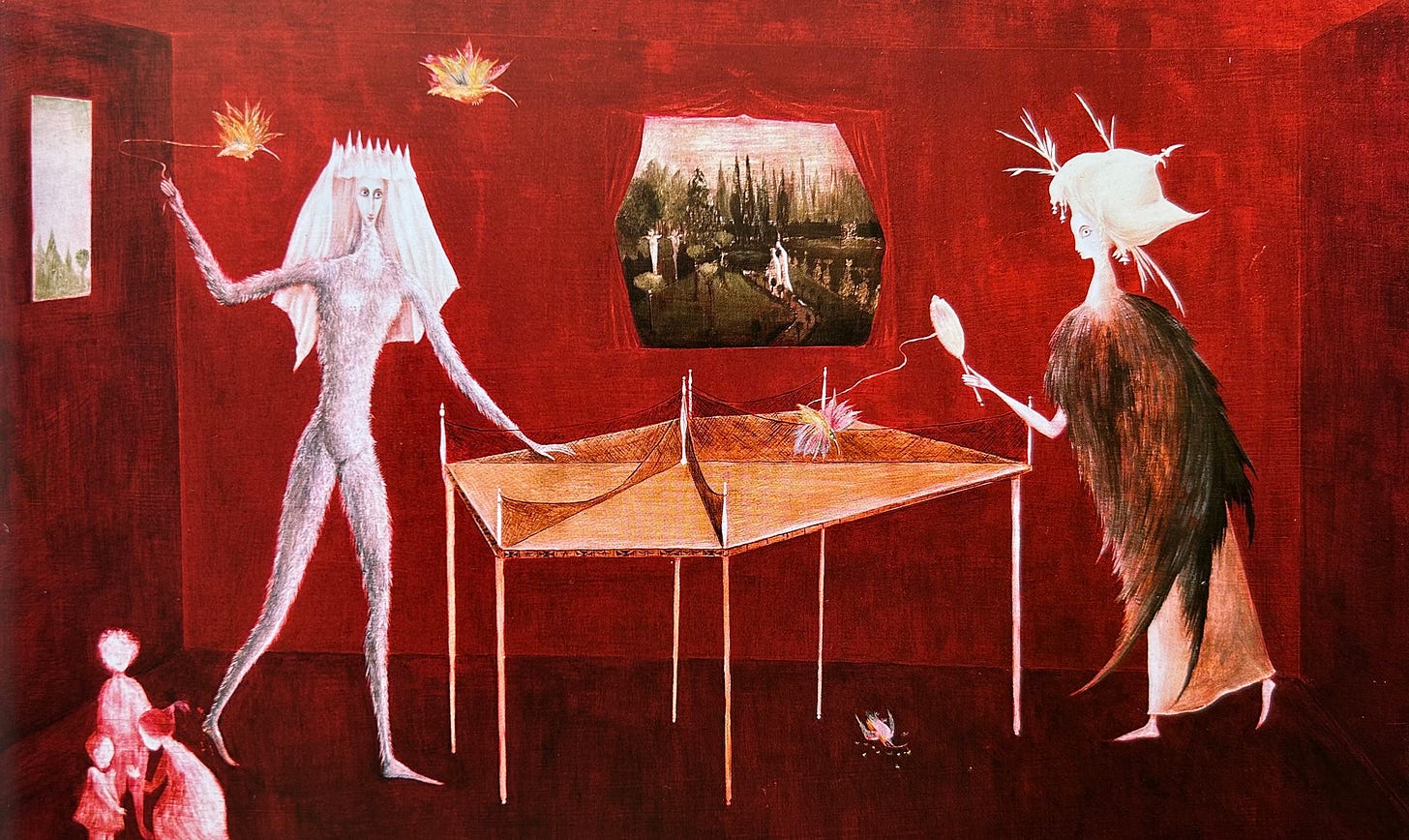

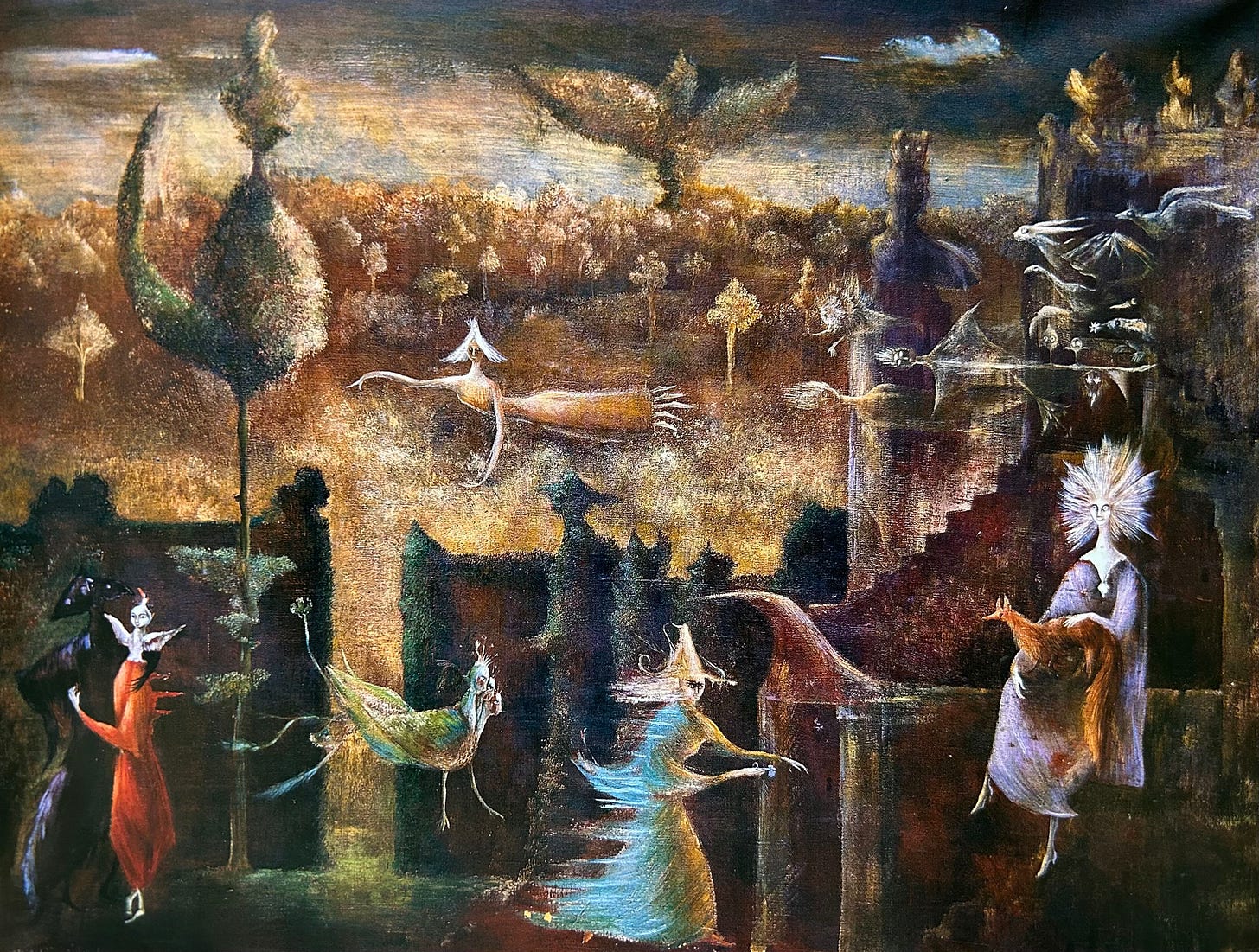
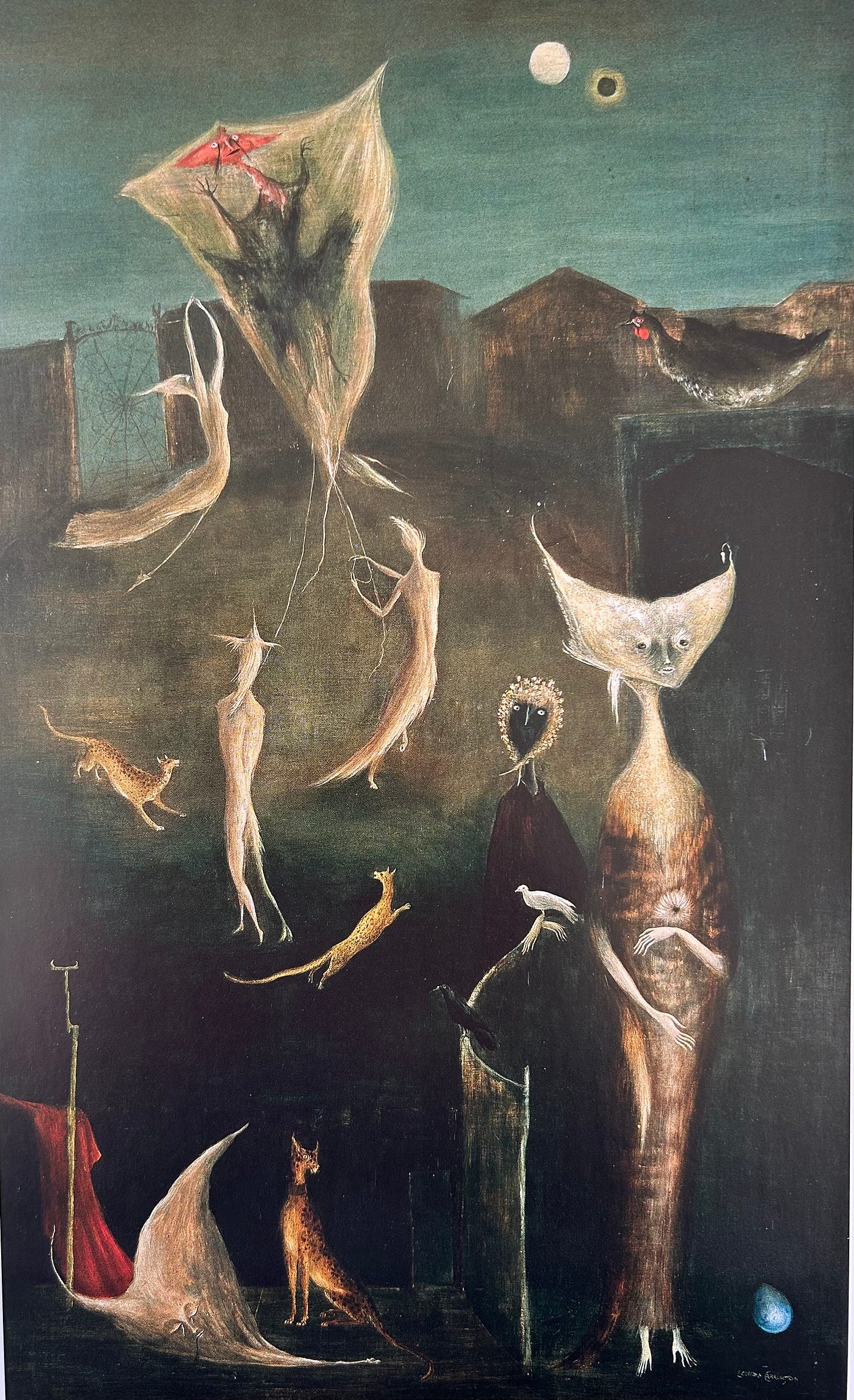
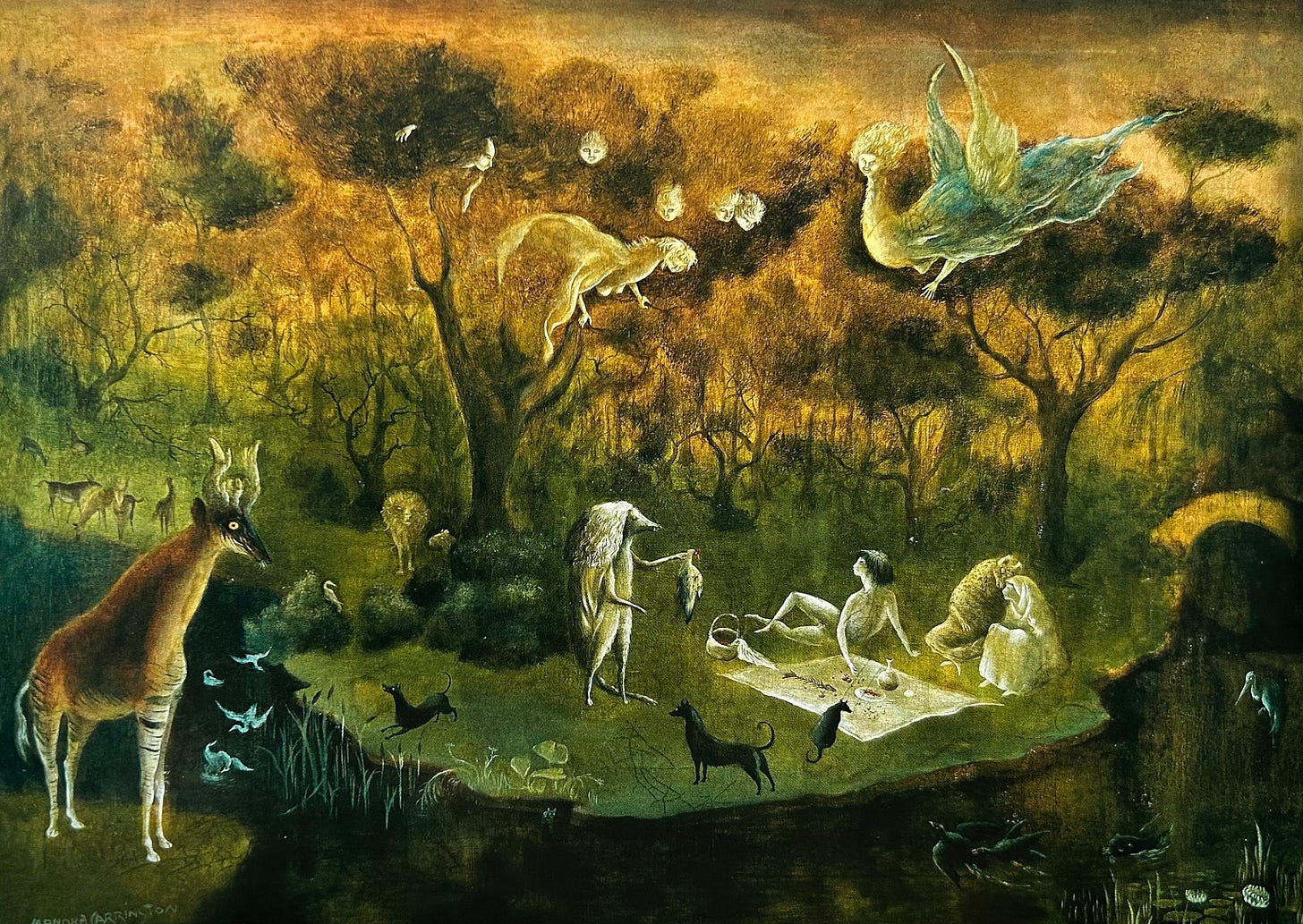


Thanks for recommending *The Hearing Trumpet*. It was a wild ride. Although I knew a smidgen about Surrealist art, I hadn’t been aware of Leonora Carrington heretofore.
Oh this is so good. I love your emphasis on imagination as a way to be in this moment, especially because anxiety often narrows our minds rather than expanding them. (In fact, I loved it so much that I stole your Breton and hooks quotes for a mindfulness talk on possibility yesterday.)